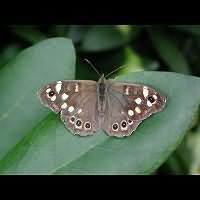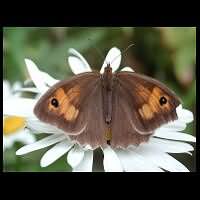The family of Browns is composed of Satyrs and Wood Nymphs. All are brownish butterflies showing eye-shaped spots, usually on both sides of both wings. These eyes either frighten the attacker or mislead them. Predators concentrate on the eyes near the edge of the wing and thus are distracted from the actual body. Besides the 'eyes' on the wings move rapidly, so the attacker gets confused and fails to apprehend the poor victim. Because all species are brown predominantly, they are also referred to as browns. The base of the veines in the wings is swollen in all browns. These parts of the vein are a very rudimentary hearing organ. Some other brush-footed butterflies also have these primitive 'ears', but not all. Nowadays many scientists believe the browns are just a subfamily of the brush-footed butterflies. This subfamily is called Satyrinae. Here we deal with them as being a separate family. In Britain some 11 species exist, in the Benelux countries some 13 species are to be found. Reaching a wingspan of some 35 to 45 mm most browns are quite small. In Southern Europe some bigger species exist, but they have never been found north of the Alps. As most browns are quite dull people tend to overlook them, even though some of the most common butterflies, such as the Wall and the Ringlet belong to this family.
The Wall Lasiommata megera
The upper side of the wings is marked not unlike those of Admirals. The other side reveals it is a Satyr after all. more...
The upper side of the wings is marked not unlike those of Admirals. The other side reveals it is a Satyr after all. more...

© Copyright 1998-2024 gardensafari.net (Hania Berdys)

 English / engels
English / engels  Dutch / nederlands
Dutch / nederlands


